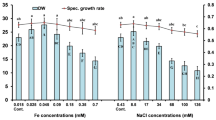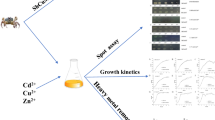Abstract
The Ubiquitin-Proteasome System (UPS) is important in protein homeostasis and is involved in many cell processes. UPS’s wide range of regulatory activities is based on the unique and diverse signals transmitted through all-encompassing processes. Cells need a fully functional UPP to cope with oxidative stress, so cellular redox status modulates ubiquitin activity. However, these protein quality control systems are compromised under adverse conditions such as heavy metal stress, resulting in pathological conditions. Heavy metals disrupt the physiological action of sensitive proteins by forming complexes with side-chain functional groups or by dislocating critical metal ions in metalloproteins. In addition, perturbation in the structure of Ubiquitin may affect the ubiquitin-proteasome pathway. In this study, it has been investigated the effects of heavy metals likewise chromium (Cr), cadmium (Cd), and mercury chloride (HgCl2) on the conformational stability of Ubiquitin as well as overcome their hazardous effect, the interaction of osmo-protectants such as Sesamol, gallic acid, Glycine, and ascorbic acid have also been explored in the study. The near and far UV-circular dichroism measurements deduced the secondary and tertiary structural changes. The size of the Ubiquitin before and after exposure to heavy metals was measured by DLS (dynamic light scattering). Docking research was also used to investigate the interaction of Ubiquitin with various heavy metals. Near and far UV-circular dichroism (CD) measurements revealed that mercury, chromium, and cadmium disrupt Ubiquitin’s secondary and tertiary structure. The effect of chromium, even at low concentrations, was significantly deleterious compared to cadmium and mercury chloride. Ubiquitin’s far-UV circular dichroism spectra subjected to heavy metals were recorded in several osmo-protectants, such as ascorbic acid, Glycine, gallic acid, and Sesamol, which offset the adverse effects of heavy metals. DLS studies revealed a noteworthy change in the hydrodynamic radius of Ubiquitin in the presence of heavy metals. Docking analysis revealed a significant binding affinity of mercury and cadmium ions with Ubiquitin. This study can infer the heavy metals’ disruption of Ubiquitin’s secondary and tertiary structure. Osmo-protectants produced by animal cells are more effective against heavy metals than plant antioxidants.





Similar content being viewed by others
Data availability
Data available on request from the authors.
Abbreviations
- Ubiquitin:
-
(Ub);
- Circular dichroism:
-
(CD);
- Ascorbic acid:
-
(Aa)
- Reactive oxygen species:
-
(ROS).
References
Tamás, M. J., Sharma, S. K., Ibstedt, S., Jacobson, T., & Christen, P. (2014). Heavy metals and metalloids as a cause for protein misfolding and aggregation. Biomolecules, 4(1), 252–267.
Da Silva, J. F., & Williams, R. J. P. (2001). The biological chemistry of the elements: the inorganic chemistry of life. Oxford University Press.
Beyersmann, D., & Hartwig, A. (2008). Carcinogenic metal compounds: Recent insight into molecular and cellular mechanisms. Archives of Toxicology, 82, 493–512.
Wysocki, R., & Tamás, M. J. (2010). How Saccharomyces cerevisiae copes with toxic metals and metalloids. FEMS Microbiology Reviews, 34(6), 925–951.
Sharma, S. K., Goloubinoff, P., & Christen, P. (2011). Non-native proteins as newly-identified targets of heavy metals and metalloids. In Cellular effects of heavy metals. Springer, Dordrecht, 263-274.
Ramadan, D., Rancy, P. C., Nagarkar, R. P., Schneider, J. P., & Thorpe, C. (2009). Arsenic (III) species inhibit oxidative protein folding in vitro. Biochemistry, 48(2), 424–432.
Jacobson, T., Navarrete, C., Sharma, S. K., Sideri, T. C., Ibstedt, S., Priya, S., Grant, C. M., Christen, P., Goloubinoff, P., & Tamás, M. J. (2012). Arsenite interferes with protein folding and triggers formation of protein aggregates in yeast. Journal of Cell Science, 125(21), 5073–5083.
Sharma, S. K., Goloubinoff, P., & Christen, P. (2008). Heavy metal ions are potent inhibitors of protein folding. Biochemical and Biophysical Research Communications, 372(2), 341–345.
Holland, S., Lodwig, E., Sideri, T., Reader, T., Clarke, I., Gkargkas, K., Hoyle, D. C., Delneri, D., Oliver, S. G., & Avery, S. V. (2007). Application of the comprehensive set of heterozygous yeast deletion mutants to elucidate the molecular basis of cellular chromium toxicity. Genome Biology, 8(12), 1–10.
Hartl, F. U., Bracher, A., & Hayer-Hartl, M. (2011). Molecular chaperones in protein folding and proteostasis. Nature, 475(7356), 324–332.
Powers, E. T., Morimoto, R. I., Dillin, A., Kelly, J. W., & Balch, W. E. (2009). Biological and chemical approaches to diseases of proteostasis deficiency. Annual Review of Biochemistry, 78, 959–991.
Stefani, M., & Dobson, C. M. (2003). Protein aggregation and aggregate toxicity: new insights into protein folding, misfolding diseases and biological evolution. Journal of Molecular Medicine, 81(11), 678–699.
Breydo, L., & Uversky, V. N. (2011). Role of metal ions in aggregation of intrinsically disordered proteins in neurodegenerative diseases. Metallomics, 3(11), 1163–1180.
Alies, B., Hureau, C., & Faller, P. (2013). The role of metal ions in amyloid formation: general principles from model peptides. Metallomics, 5(3), 183–192.
Caudle, W. M., Guillot, T. S., Lazo, C. R., & Miller, G. W. (2012). Industrial toxicants and Parkinson’s disease. Neurotoxicology, 33(2), 178–188.
Savelieff, M. G., Lee, S., Liu, Y., & Lim, M. H. (2013). Untangling amyloid-β, tau, and metals in Alzheimer’s disease. ACS Chemical Biology, 8(5), 856–865.
Bourassa, M. W., & Miller, L. M. (2012). Metal imaging in neurodegenerative diseases. Metallomics, 4(8), 721–738.
Greenough, M. A., Camakaris, J., & Bush, A. I. (2013). Metal dyshomeostasis and oxidative stress in Alzheimer’s disease. Neurochemistry International, 62(5), 540–555.
Díaz-Villanueva, J. F., Díaz-Molina, R., & García-González, V. (2015). Protein folding and mechanisms of proteostasis. International Journal of Molecular Sciences, 16(8), 17193–17230.
Herberhold, H., & Winter, R. (2002). Temperature-and pressure-induced unfolding and refolding of ubiquitin: A static and kinetic Fourier transform infrared spectroscopy study. Biochemistry, 41(7), 2396–2401.
Khaliq, B., Iqbal, S., Falke, S., Buck, F., Munawar, A., Mahmood, S., Betzel, C., & Akrem, A. (2017). Characterization and In-Silico Studies on Ubiquitin Protein from Seeds of Sisymbrium irio. Pakistan Journal of Life & Social Sciences, 15, 1.
Goto, Y., Takahashi, N., & Fink, A. L. (1990). Mechanism of acid-induced folding of proteins. Biochemistry, 29(14), 3480–3488.
Puett, D. (1973). The Eguilibrium Unfolding Parameters Horse and Sperm Whale Myoglobin., 248(13), 4623–34.
Guex, N., & Peitsch, M. C. (1997). SWISS‐MODEL and the Swiss‐Pdb Viewer: an environment for comparative protein modeling. Electrophoresis, 18(15), 2714–2723.
Morris, G. M., Huey, R., Lindstrom, W., Sanner, M. F., Belew, R. K., Goodsell, D. S., & Olson, A. J. (2009). AutoDock4 and AutoDockTools4: Automated docking with selective receptor flexibility. Journal of Computational Chemistry, 30(16), 2785–2791.
Park, S. H. (2008). Characterization of the molten globule conformation of V26A ubiquitin by far-UV circular dichroic spectroscopy and amide hydrogen/deuterium exchange. BMB Reports, 41(1), 35–40.
Alazoumi, K. K., Ahmed, A., Alamery, S. F., Shamsi, A., Ahmad, B., Islam, A., & Farooqi, H. (2021). Effect of Antioxidants on Heavy Metals Induced Conformational Alteration of Cytochrome C and Myoglobin. Protein and Peptide Letters, 28(1), 31–42.
Shamsi, A., Ahmed, A., Khan, M. S., Husain, F. M., Amani, S., & Bano, B. (2018). Investigating the interaction of anticancer drug temsirolimus with human transferrin: Molecular docking and spectroscopic approach. Journal of Molecular Recognition, 31(10), e2728.
Jan, A. T., Azam, M., Siddiqui, K., Ali, A., Choi, I., & Haq, Q. M. (2015). Heavy metals and human health: mechanistic insight into toxicity and counter defense system of antioxidants. International Journal of Molecular Sciences, 16(12), 29592–29630.
Parray, Z. A., Shahid, S., Ahmad, F., Hassan, M. I., & Islam, A. (2015). Characterization of intermediate state of myoglobin in the presence of PEG 10 under physiological conditions. International Journal of Biological Macromolecules, 99, 241–248.
Monteiro, C., Santos, C., Bastos, V., & Oliveira, H. (2019). Cr (VI)‐induced genotoxicity and cell cycle arrest in human osteoblast cell line MG‐63. Journal of Applied Toxicology, 39(7), 1057–1065.
Yin, F., Yan, J., Zhao, Y., Guo, K. J., Zhang, Z. L., Li, A. P., Meng, C. Y., & Guo, L. (2019). Bone marrow mesenchymal stem cells repair Cr (VI)-injured kidney by regulating mitochondria-mediated apoptosis and mitophagy mediated via the MAPK signaling pathway. Ecotoxicology and Environmental Safety, 176, 234–241.
Hassan, M., Abd-Elwahab, W., Megahed, R., & Mohammed, A. (2019). An Evaluation of Hepatotoxicity, Nephrotoxicity, and Genotoxicity Induced by Acute Toxicity of Hexavalent Chromium and Comparison of the Possible Protective Role of Selenium and Vitamin E on These Effects. Ain Shams Journal of Forensic Medicine and Clinical Toxicology, 33(2), 48–58.
Hu, G., Feng, H., Long, C., Zhou, D., Li, P., Gao, X., Chen, Z., Wang, T., & Jia, G. (2019). LncRNA expression profiling and its relationship with DNA damage in Cr (VI)-treated 16HBE cells. Science of The Total Environment, 655, 622–632.
Schlierf, M., Li, H., & Fernandez, J. M. (2004). The unfolding kinetics of ubiquitin captured with single-molecule force-clamp techniques. Proceedings of the National Academy of Sciences, 101(19), 7299–7304.
Irbäck, A., Mitternacht, S., & Mohanty, S. (2005). Dissecting the mechanical unfolding of ubiquitin. Proceedings of the National Academy of Sciences, 102(38), 13427–13432.
Naiyer, A., Hassan, M. I., Islam, A., Sundd, M., & Ahmad, F. (2015). Structural characterization of MG and pre-MG states of proteins by MD simulations, NMR, and other techniques. Journal of Biomolecular Structure and Dynamics, 33(10), 2267–2284.
Kundu, N., Ghosh, R. K., Kar, T., Bhattacharyya, M., & Basak, P. (2016). Illustration of fluorescence quenching mechanism of heme proteins using stern volumer quenching system with determination of positioning of trypohan residues. Journal of Global Biosciences, 5(9), 4579–4584.
Ikeguchi, M., Kuwajima, K., Mitani, M., & Sugai, S. (1986). Evidence for identity between the equilibrium unfolding intermediate and a transient folding intermediate: a comparative study of the folding reactions of. alpha.-lactalbumin and lysozyme. Biochemistry, 25(22), 6965–6972.
Hasanbašić, S., Jahić, A., Berbić, S., Žnidarič, M. T., & Žerovnik, E. (2018). Inhibition of protein aggregation by several antioxidants. Oxidative Medicine and Cellular Longevity, 2018, 1-12.
Tamás, M. J., Fauvet, B., Christen, P., & Goloubinoff, P. (2018). Misfolding and aggregation of nascent proteins: a novel mode of toxic cadmium action in vivo. Current Genetics, 64(1), 177–181.
Sumner, E. R., Shanmuganathan, A., Sideri, T. C., Willetts, S. A., Houghton, J. E., & Avery, S. V. (2005). Oxidative protein damage causes chromium toxicity in yeast. Microbiology, 151(6), 1939–1948.
Acknowledgements
K.K. is thankful to the Ministry of Higher Education, Libya, for providing fellowship. The authors are highly grateful to Jamia Hamdard, Jamia Millia Islamia, and ACBR New Delhi for providing the necessary facilities to carry out this research.
Author contributions
H.F. conceptualized and provided the primary facility for the study. K.K. and P.S. were involved with the methodology execution and manuscript drafting. A.I. performed data analysis and manuscript Revision.
Author information
Authors and Affiliations
Corresponding author
Ethics declarations
Conflict of interest
The authors declare no competing interests.
Additional information
Publisher’s note Springer Nature remains neutral with regard to jurisdictional claims in published maps and institutional affiliations.
Rights and permissions
Springer Nature or its licensor (e.g. a society or other partner) holds exclusive rights to this article under a publishing agreement with the author(s) or other rightsholder(s); author self-archiving of the accepted manuscript version of this article is solely governed by the terms of such publishing agreement and applicable law.
About this article
Cite this article
Alazoumi, K.K.M., Sharma, P., Islam, A. et al. Mitigation of the Deleterious Effect of Heavy Metals on the Conformational Stability of Ubiquitin through Osmoprotectants. Cell Biochem Biophys 82, 193–202 (2024). https://doi.org/10.1007/s12013-023-01188-3
Received:
Accepted:
Published:
Issue Date:
DOI: https://doi.org/10.1007/s12013-023-01188-3




